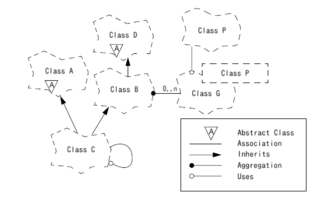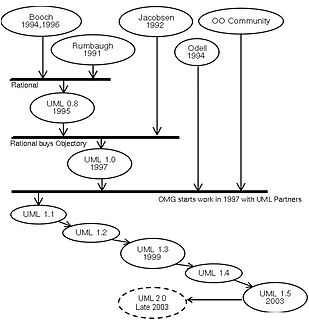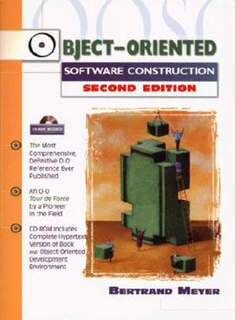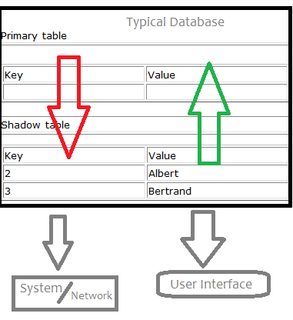 W
WThe Booch method is a method for object-oriented software development. It is composed of an object modeling language, an iterative object-oriented development process, and a set of recommended practices.
 W
WThe Common Lisp Object System (CLOS) is the facility for object-oriented programming which is part of ANSI Common Lisp. CLOS is a powerful dynamic object system which differs radically from the OOP facilities found in more static languages such as C++ or Java. CLOS was inspired by earlier Lisp object systems such as MIT Flavors and CommonLoops, although it is more general than either. Originally proposed as an add-on, CLOS was adopted as part of the ANSI standard for Common Lisp and has been adapted into other Lisp dialects such as EuLisp or Emacs Lisp.
 W
WComponent-based software engineering (CBSE), also called components-based development (CBD), is a branch of software engineering that emphasizes the separation of concerns with respect to the wide-ranging functionality available throughout a given software system. It is a reuse-based approach to defining, implementing and composing loosely coupled independent components into systems. This practice aims to bring about an equally wide-ranging degree of benefits in both the short-term and the long-term for the software itself and for organizations that sponsor such software.
 W
WEiffelStudio is a development environment for the Eiffel programming language developed and distributed by Eiffel Software.
 W
WIn object-oriented programming (OOP), a factory is an object for creating other objects – formally a factory is a function or method that returns objects of a varying prototype or class from some method call, which is assumed to be "new". More broadly, a subroutine that returns a "new" object may be referred to as a "factory", as in factory method or factory function. This is a basic concept in OOP, and forms the basis for a number of related software design patterns.
 W
WIn computing, the System Object Model (SOM) is an object-oriented shared library system developed by IBM. DSOM, a distributed version based on CORBA, allowed objects on different computers to communicate.
 W
WIDEF4, or Integrated DEFinition for Object-Oriented Design, is an object-oriented design modeling language for the design of component-based client/server systems. It has been designed to support smooth transition from the application domain and requirements analysis models to the design and to actual source code generation. It specifies design objects with sufficient detail to enable source code generation.
 W
WThe Journal of Object Technology is an online scientific journal welcoming manuscripts describing theoretical, empirical, conceptual, and experimental results in the area of software and language engineering, including programming paradigms software language engineering model-based and model-driven engineering requirement engineering software architecture software validation & verification software maintenance and evolution software analytics software development process and methodology
 W
WLePUS3 is a language for modelling and visualizing object-oriented programs and design patterns. It is defined as a formal specification language, formulated as an axiomatized subset of First-order predicate logic. A diagram in LePUS3 is also called a Codechart. LePUS, the name of the first version of the language, is an abbreviation for Language for Pattern Uniform Specification.
 W
WModelica is an object-oriented, declarative, multi-domain modeling language for component-oriented modeling of complex systems, e.g., systems containing mechanical, electrical, electronic, hydraulic, thermal, control, electric power or process-oriented subcomponents. The free Modelica language is developed by the non-profit Modelica Association. The Modelica Association also develops the free Modelica Standard Library that contains about 1400 generic model components and 1200 functions in various domains, as of version 4.0.0.
 W
WAn object database is a database management system in which information is represented in the form of objects as used in object-oriented programming. Object databases are different from relational databases which are table-oriented. Object-relational databases are a hybrid of both approaches.
 W
WAn object-modeling language is a standardized set of symbols used to model a software system using an object-oriented framework. The symbols can be either informal or formal ranging from predefined graphical templates to formal object models defined by grammars and specifications.
 W
WThe object-modeling technique (OMT) is an object modeling approach for software modeling and designing. It was developed around 1991 by Rumbaugh, Blaha, Premerlani, Eddy and Lorensen as a method to develop object-oriented systems and to support object-oriented programming. OMT describes object model or static structure of the system.
 W
WObject-Oriented Software Construction is a book by Bertrand Meyer, widely considered a foundational text of object-oriented programming. The first edition was published in 1988; the second, extensively revised and expanded edition, in 1997. Numerous translations are available including Dutch, French (1+2), German (1), Italian (1), Japanese (1+2), Persian (1), Polish (2), Romanian (1), Russian (2), Serbian (2), and Spanish (2). The book has been cited thousands of times in computer science literature. The book won a Jolt award in 1994.
 W
WQP is a family of lightweight, open source software frameworks for building responsive and modular real-time embedded applications as systems of cooperating, event-driven active objects (actors).
 W
WShadow tables are objects in computer science used to improve the way machines, networks and programs handle information. More specifically, a shadow table is an object that is read and written by a processor and contains data similar to its primary table, which is the table it's "shadowing". Shadow tables usually contain data that is relevant to the operation and maintenance of its primary table, but not within the subset of data required for the primary table to exist. Shadow tables are related to the data type "trails" in data storage systems. Trails are very similar to shadow tables but instead of storing identically formatted information that is different, they store a history of modifications and functions operated on a table.